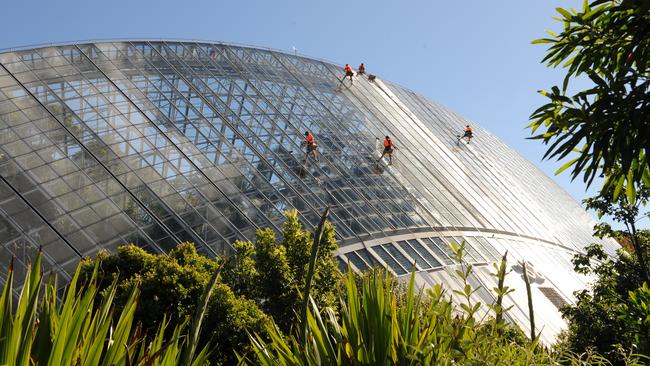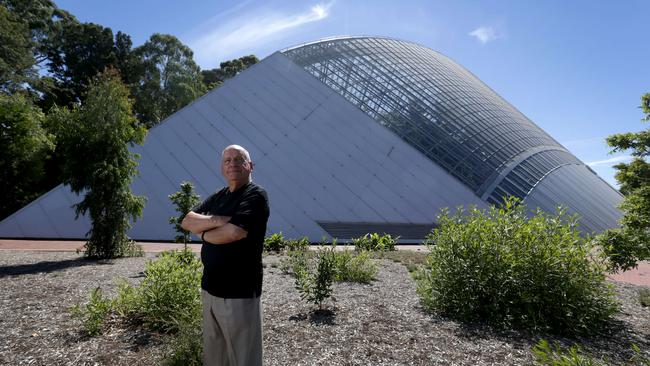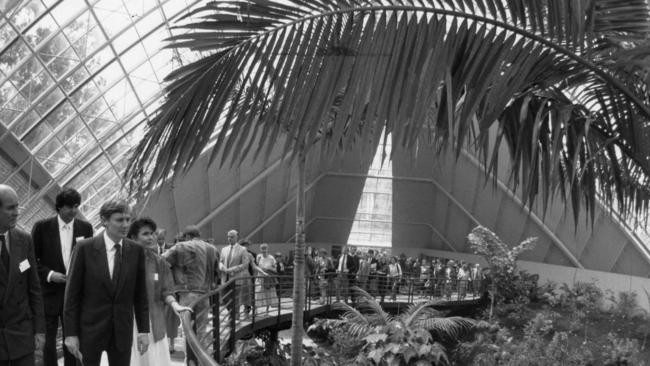Botanic Gardens Bicentennial Conservatory needs $13m upgrade after audit notes risk of falling glass
The soaring iconic curved glass panels of the Bicentennial Conservatory could be a ticking time bomb, an audit reveals.

SA News
Don't miss out on the headlines from SA News. Followed categories will be added to My News.
The entire facade of the Bicentennial Conservatory should be replaced as part of a $13m repair bill amid concern glass panels could shatter and fall on the public, an audit says.
A consultants’ investigation has found “significant deficiencies” with the condition of the landmark state heritage-listed glasshouse in the Adelaide Botanic Gardens and that it should be restored.
The audit was triggered after DTI and Adelaide Botanic Gardens identified “corrosion” across “significant areas” of the nationally-significant building, which opened in 1989 and is the largest single-span glasshouse in the southern hemisphere.
Among issues identified during the audit carried out in July and August 2019 by DASH Architects, Arup, Bestec and Rider Levett Bucknall were:
CONSTRUCTION defects in the facade glazing system allowed water to leak into the building;
TOUGHENED glass panels did not meet building code, posed a “safety risk” and will break and fall on people below if overloaded or if they cracked;
CONCERNS that the glazing would not be able to withstand severe weather and;
GASKETS and silicone sealants had reached the “end of their design life”.

The report, which also identified “noncomplying” balustrades, calculated that “ad hoc” repairs and maintenance costing $1.3 should be avoided and rather recommended a $13m overhaul.
“As the entire facade and steel coating system has reached the end of its design life, there may be cost efficiencies in full removal and replacement of the entirety of the building envelope (inclusive of glazed and solid cladding zones) at the same time as conducting the steel recoating works …,” the report says.
“This will result in a facade system and primary structure that should require little or no maintenance (other than required cleaning and checks typical for the installed products) for the next 25-30 years.”
But the repair bill could be higher given inspection by engineer firm Arup was “limited to areas where reasonable and safe access was available”.
The report was published in February 2020 but has been released by the Environment Department following a Freedom of Information request.

The conservatory, designed by South Australian architect Guy Maron, was commissioned in celebration of Australia’s 1988 bicentenary and was opened initially to house the Botanic Gardens’ tropical rainforest plant collection.
The audit follows an earlier report in 2011, conducted in partnership with Mr Maron, which made a number of recommendations to improve the operation of the 100m long conservatory and determine a maintenance schedule.
But the only recommended action was to turn heating off to cut greenhouse gas emissions.
An Adelaide Botanic Gardens masterplan released last August has recommended a “detailed” building condition audit of the conservatory and to “assess and act on the recommendations of recent reviews of the building to protect and conserve the heritage-listed structure.”
The masterplan report noted that ageing sprinklers carry legionella risks to the public.
In a statement Botanic Gardens and State Herbarium Director Dr Lucy Sutherland said the conservatory was “safe and sound” and that work has started to “ensure it remains open for the public to enjoy.”
She said a final masterplan will be released this year.
THE BICENTENNIAL CONSERVATORY
Architect: Guy Maron
Dimensions: 100m x 47m x 27m
Opened: 1989
Featuring 2,434 sqm of toughened glass, it was built to commemorate Australia’s bicentenary and to house the Botanic Gardens rainforest collection. Plant species changed to subtropical species after heating system was turned off in 2013.
Entered on the State Heritage Register in 2014 (the youngest building on the register at the time) and received the Australian Institute of Architects Sir Zelman Cowan Award for public buildings in 1991.
Entry to the conservatory is free





